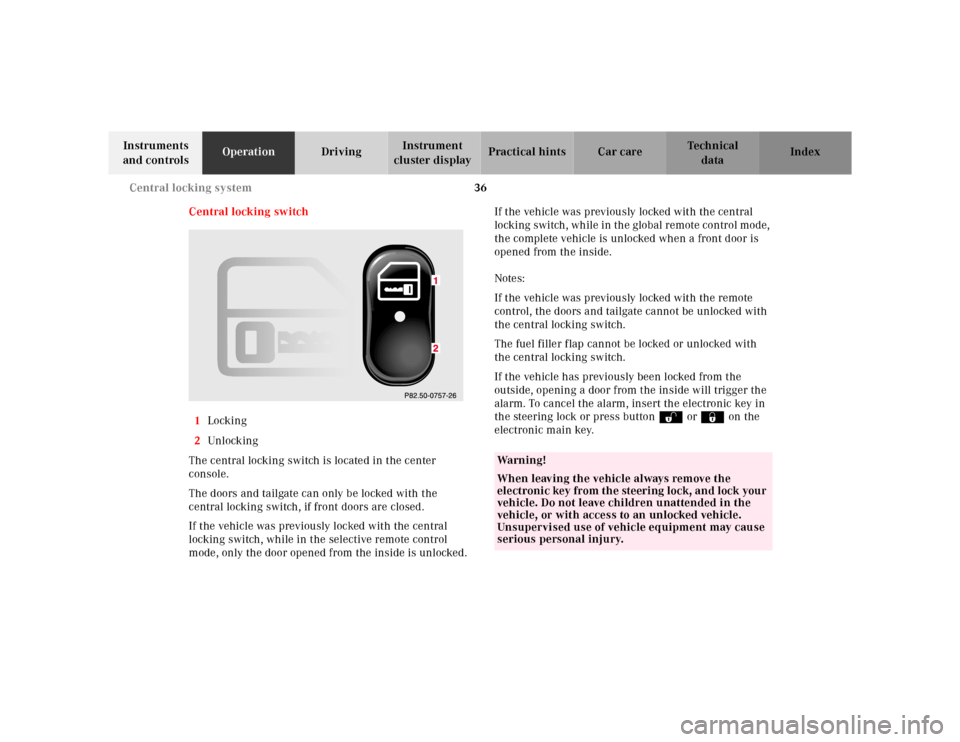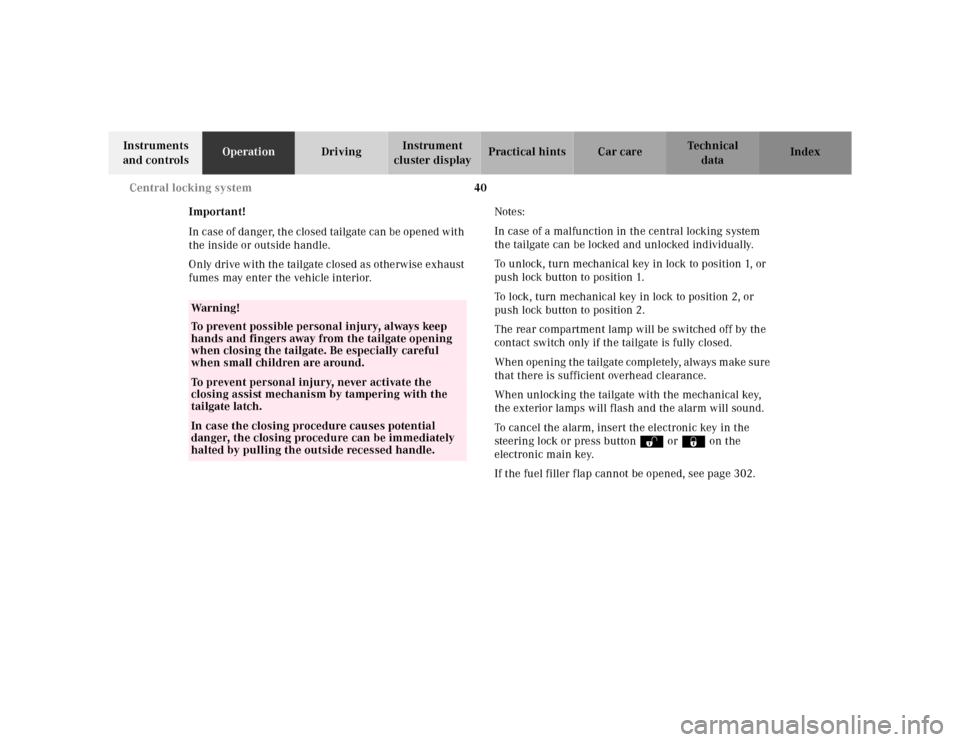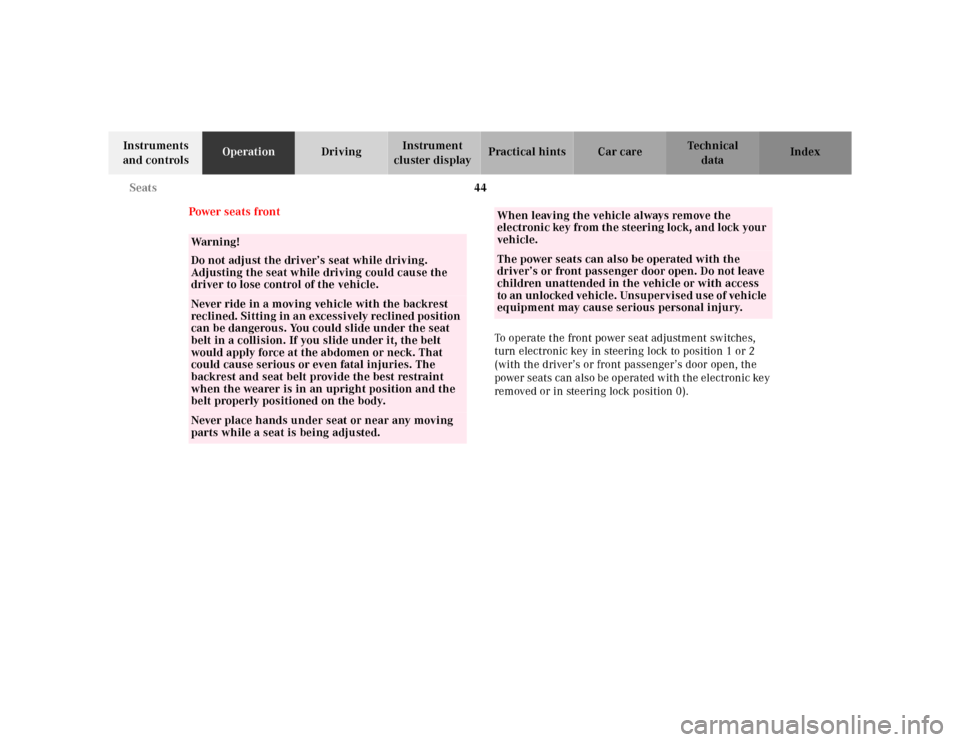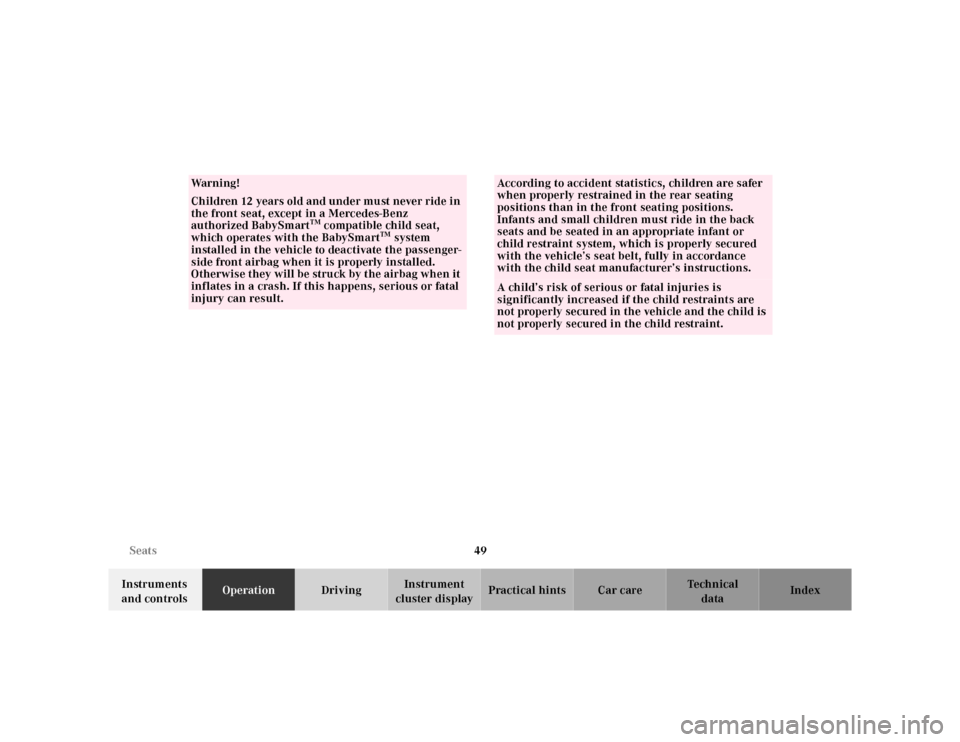2001 MERCEDES-BENZ E-Class WAGON child
[x] Cancel search: childPage 4 of 345

1 Contents
IntroductionProduct information .......................... 7
Operator’s manual ............................. 8
Where to find it ................................ 13
Reporting Safety Defects ................ 15Instruments and controlsInstruments and controls ............... 18
Center console .............................. 20
Overhead control panel ............... 21OperationVehicle keys ...................................... 24
Start lock-out..................................... 27
General notes on the
central locking system ............... 28
Central locking system ................... 29
Radio frequency and
infrared remote control ............... 29
Opening and closing windows
and sliding/pop-up roof
from outside .................................. 32
Panic button .................................. 33Mechanical keys .......................... 33
Doors ................................................. 34
Central locking switch.................... 36
Automatic central locking.............. 37
Emergency unlocking
in case of accident ...................... 37
Tailgate.............................................. 38
Antitheft alarm system.................... 41
Tow-away alarm ............................... 43
Power seats front ............................. 44
Front seat head restraints.............. 50
Rear seat head restraints ................ 51
Multicontour seat ............................ 53
Seat heater........................................ 54
Seat ventilation................................ 57
Seat belts and integrated
restraint system .......................... 59
Seat belts .......................................... 59
Seat belt nonusage
warning system........................... 60
BabySmart
TM airbag
deactivation system.................... 67Self-test BabySmart
TM
without special
child seat installed ....................... 67
Supplemental restraint
system (SRS) ................................ 68
Emergency tensioning
retractor (ETR)............................. 69
Airbags .............................................. 70
Safety guidelines for the
seat belt, emergency
tensioning retractor
and airbag .................................... 76
Infant and child
restraint systems......................... 78
Steering wheel adjustment............. 81
Rear view mirrors ............................ 82
Instrument cluster ........................... 86
Multifunction steering wheel,
multifunction display ................. 92
Trip and main odometer,
vehicle speed, FSS
and engine oil level display....... 96
Audio systems .................................. 97
Radio .............................................. 97
CD player ....................................... 98
Page 25 of 345

22 Contents - Operation
Te ch n ica l
data Instruments
and controlsOperationDrivingInstrument
cluster displayPractical hints Car care Index
OperationVehicle keys ...................................... 24
Start lock-out..................................... 27
General notes on the
central locking system ............... 28
Central locking system ................... 29
Radio frequency and
infrared remote control ............... 29
Opening and closing windows
and sliding/pop-up roof
from outside .................................. 32
Panic button .................................. 33
Mechanical keys ........................... 33
Doors .................................................. 34
Central locking switch .................... 36
Automatic central locking .............. 37
Emergency unlocking
in case of accident ...................... 37
Tailgate .............................................. 38
Antitheft alarm system ................... 41
Tow-away alarm................................ 43
Power seats front ............................. 44
Front seat head restraints .............. 50Rear seat head restraints ................ 51
Multicontour seat ............................ 53
Seat heater........................................ 54
Seat ventilation................................ 57
Seat belts and integrated
restraint system .......................... 59
Seat belts .......................................... 59
Seat belt nonusage
warning system........................... 60
BabySmart
TM airbag
deactivation system.................... 67
Self-test BabySmart
TM
without special
child seat installed ...................... 67
Supplemental restraint
system (SRS)................................ 68
Emergency tensioning
retractor (ETR) ............................ 69
Airbags.............................................. 70
Safety guidelines for the
seat belt, emergency
tensioning retractor
and airbag ..................................... 76
Infant and child
restraint systems ........................ 78Steering wheel adjustment............. 81
Rear view mirrors ............................ 82
Instrument cluster ........................... 86
Multifunction steering wheel,
multifunction display ................. 92
Trip and main odometer,
vehicle speed, FSS
and engine oil level display....... 96
Audio systems .................................. 97
Radio .............................................. 97
CD player ....................................... 98
Cassette player ............................. 99
Telephone ........................................ 100
Telephone book .......................... 100
Redialing ..................................... 102
Incoming call .............................. 104
Navigation system .......................... 105
Trip computer ................................. 106
Malfunction
message memory ...................... 108
Individual settings......................... 110
Setting the audio volume............... 113
Flexible service system
(FSS)............................................ 114
Page 27 of 345

24 Central locking system
Te ch n ica l
data Instruments
and controlsOperationDrivingInstrument
cluster displayPractical hints Car care Index
Ve h i c l e k ey s
Included with your vehicle are:
•2 electronic main keys with integrated radio
frequency and infrared remote controls plus
removable mechanical key.
•1 electronic reserve key without remote control
functions, plus removable mechanical key.
The locking tabs for the mechanical key portion of the
two electronic main keys are a different color to help
distinguish it.
Wa r n i n g !
When leaving the vehicle always remove the
electronic key from the steering lock, and lock your
vehicle. Do not leave children unattended in the
vehicle, or with access to an unlocked vehicle.
Unsupervised use of vehicle equipment may cause
serious personal injury.
Page 39 of 345

36 Central locking system
Te ch n ica l
data Instruments
and controlsOperationDrivingInstrument
cluster displayPractical hints Car care Index
Central locking switch
1Locking
2Unl ock ing
The central locking switch is located in the center
console.
The doors and tailgate can only be locked with the
central locking switch, if front doors are closed.
If the vehicle was previously locked with the central
locking switch, while in the selective remote control
mode, only the door opened from the inside is unlocked.If the vehicle was previously locked with the central
locking switch, while in the global remote control mode,
the complete vehicle is unlocked when a front door is
opened from the inside.
Notes:
If the vehicle was previously locked with the remote
control, the doors and tailgate cannot be unlocked with
the central locking switch.
The fuel filler flap cannot be locked or unlocked with
the central locking switch.
If the vehicle has previously been locked from the
outside, opening a door from the inside will trigger the
alarm. To cancel the alarm, insert the electronic key in
the steering lock or press buttonŒ or‹ on the
electronic main key.
Wa r n i n g !
When leaving the vehicle always remove the
electronic key from the steering lock, and lock your
vehicle. Do not leave children unattended in the
vehicle, or with access to an unlocked vehicle.
Unsupervised use of vehicle equipment may cause
serious personal injury.
Page 43 of 345

40 Central locking system
Te ch n ica l
data Instruments
and controlsOperationDrivingInstrument
cluster displayPractical hints Car care Index
Important!
In case of danger, the closed tailgate can be opened with
the inside or outside handle.
Only drive with the tailgate closed as otherwise exhaust
fumes may enter the vehicle interior.Notes:
In case of a malfunction in the central locking system
the tailgate can be locked and unlocked individually.
To unlock, turn mechanical key in lock to position 1, or
push lock button to position 1.
To lock, turn mechanical key in lock to position 2, or
push lock button to position 2.
The rear compartment lamp will be switched off by the
contact switch only if the tailgate is fully closed.
When opening the tailgate completely, always make sure
that there is sufficient overhead clearance.
When unlocking the tailgate with the mechanical key,
the exterior lamps will flash and the alarm will sound.
To cancel the alarm, insert the electronic key in the
steering lock or press buttonŒ or‹ on the
electronic main key.
If the fuel filler flap cannot be opened, see page 302.
Wa r n i n g !
To prevent possible personal injury, always keep
hands and fingers away from the tailgate opening
when closing the tailgate. Be especially careful
when small children are around.To prevent personal injury, never activate the
closing assist mechanism by tampering with the
tailgate latch.In case the closing procedure causes potential
danger, the closing procedure can be immediately
halted by pulling the outside recessed handle.
Page 47 of 345

44 Seats
Te ch n ica l
data Instruments
and controlsOperationDrivingInstrument
cluster displayPractical hints Car care Index
Power seats front
To operate the front power seat adjustment switches,
turn electronic key in steering lock to position 1 or 2
(with the driver’s or front passenger’s door open, the
power seats can also be operated with the electronic key
removed or in steering lock position 0).
Wa r n i n g !
Do not adjust the driver’s seat while driving.
Adjusting the seat while driving could cause the
driver to lose control of the vehicle.Never ride in a moving vehicle with the backrest
reclined. Sitting in an excessively reclined position
can be dangerous. You could slide under the seat
belt in a collision. If you slide under it, the belt
would apply force at the abdomen or neck. That
could cause serious or even fatal injuries. The
backrest and seat belt provide the best restraint
when the wearer is in an upright position and the
belt properly positioned on the body.Never place hands under seat or near any moving
parts while a seat is being adjusted.
When leaving the vehicle always remove the
electronic key from the steering lock, and lock your
vehicle.The power seats can also be operated with the
driver’s or front passenger door open. Do not leave
children unattended in the vehicle or with access
to an unlocked vehicle. Unsupervised use of vehicle
equipment may cause serious personal injury.
Page 51 of 345

48 Seats
Te ch n ica l
data Instruments
and controlsOperationDrivingInstrument
cluster displayPractical hints Car care Index
Recalling positions from memory
To recall a seat / head restraint / steering wheel and
exterior rear view mirror position, push and hold
position button “1”, “2” or “3” until seat / head restraint /
steering wheel and exterior rear view mirror movement
has stopped. The seat / head restraint / steering wheel
and exterior rear view mirror movement stops when the
position button is released.
Caution!
Do not operate the power seats using the memory
button if the seat backrest is in an excessively reclined
position. Doing so could cause damage to front or rear
seats.
First move the backrest to an upright position.Important!
Prior to operating the vehicle, the driver should adjust
the seat height for proper vision as well as fore / aft
placement and backrest angle to ensure adequate
control, reach, operation, and comfort. The head
restraint should also be adjusted for proper height. See
also airbag section for proper seat positioning.
In addition, also adjust the steering wheel to ensure
adequate control, reach, operation, and comfort.
Both the inside and outside rear view mirrors should be
adjusted for adequate rearward vision.
Fasten seat belts. Infants and small children should be
seated in a properly secured restraint system that
complies with U.S. Federal Motor Vehicle Safety
Standard 213 and Canadian Motor Vehicle Safety
Stand ard 213.1.
All seat, head restraint, steering wheel, and rear view
mirror adjustments as well as fastening of seat belts
should be done before the vehicle is put into motion.
Page 52 of 345

49 Seats
Te ch n ica l
data Instruments
and controlsOperationDrivingInstrument
cluster displayPractical hints Car care Index
Wa r n i n g !
Children 12 years old and under must never ride in
the front seat, except in a Mercedes-Benz
authorized BabySmart
TM compatible child seat,
which operates with the BabySmart
TM system
installed in the vehicle to deactivate the passenger-
side front airbag when it is properly installed.
Otherwise they will be struck by the airbag when it
inflates in a crash. If this happens, serious or fatal
injury can result.
According to accident statistics, children are safer
when properly restrained in the rear seating
positions than in the front seating positions.
Infants and small children must ride in the back
seats and be seated in an appropriate infant or
child restraint system, which is properly secured
with the vehicle’s seat belt, fully in accordance
with the child seat manufacturer’s instructions.A child’s risk of serious or fatal injuries is
significantly increased if the child restraints are
not properly secured in the vehicle and the child is
not properly secured in the child restraint.